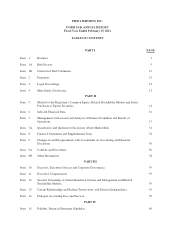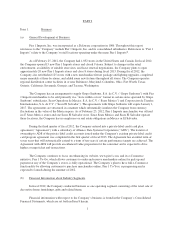Pier 1 2012 Annual Report Download - page 18
Download and view the complete annual report
Please find page 18 of the 2012 Pier 1 annual report below. You can navigate through the pages in the report by either clicking on the pages listed below, or by using the keyword search tool below to find specific information within the annual report.The expansion of the Company’s e-Commerce business has inherent cybersecurity risks that may disrupt
its business.
The Company’s strategic plans to have full e-Commerce functionality in the United States may increase
the Company’s exposure to cybersecurity risks. A compromise of its security systems could result in a service
disruption, or customers’ personal information or the Company’s proprietary information being obtained by
unauthorized users. Although the Company has implemented processes to mitigate the risks of security breaches
and cyber incidents, there can be no assurance that such an attack will not occur. Any breach of the Company’s
security could result in violation of privacy laws, potential litigation, and a loss of confidence in its security
measures, all of which could have a negative impact on the Company’s financial results and its reputation.
Regulatory Risks
The Company is subject to laws and regulatory requirements in many jurisdictions. Changes in these
laws and requirements may result in additional costs to the Company, including the costs of compliance as well
as potential penalties for non-compliance.
Legislation on a local, regional, state or national level has the potential to have a negative effect on the
Company’s profitability or ability to operate its business. Compliance with certain legislation carries with it
significant costs. The Company is subject to oversight by many governmental agencies in the course of operating
its business because of its numerous locations, large number of employees, contact with consumers and
importation and exportation of product. In addition, the Company is subject to regulations regarding consumer
product quality and safety standards. Complying with regulations may cause the Company to incur significant
expenses, including the costs associated with periodic audits. Failure to comply may also result in additional
costs in the form of penalties.
The Company operates in many taxing jurisdictions, including foreign countries. In most of these
jurisdictions, the Company is required to collect state and local sales taxes at the point of sale and remit them to
the appropriate taxing authority. The Company is also subject to income taxes, excise taxes, franchise taxes,
payroll taxes and other special taxes. The Company is also required to maintain various kinds of business and
commercial licenses to operate its stores and other facilities. Rates of taxation are beyond the Company’s control,
and increases in such rates or taxation methods and rules could have a negative impact on the Company’s
financial results. Failure to comply with laws concerning the collection and remittance of taxes and with
licensing requirements could also subject the Company to financial penalties or business interruptions.
Risks Associated with International Trade
As a retailer of imported merchandise, the Company is subject to certain risks that typically do not affect
retailers of domestically produced merchandise.
The Company may order merchandise well in advance of delivery and generally takes title to the
merchandise at the time it is loaded for transport to designated U.S. destinations. Global political unrest, war,
threats of war, terrorist acts or threats, especially threats to foreign and U.S. ports and piracy, disruption in the
operation of the international portion of the Company’s supply chain, or natural disasters could affect the
Company’s ability to import merchandise from certain countries. Fluctuations in foreign currency exchange rates
and the relative value of the U.S. dollar, restrictions on the convertibility of the dollar and other currencies,
duties, taxes and other charges on imports, dock strikes, import quota systems and other restrictions sometimes
placed on foreign trade can affect the price, delivery and availability of imported merchandise as well as exports
to the Company’s stores in other countries. The inability to import merchandise from China and other countries,
unavailability of adequate shipping capacity at reasonable rates, or the imposition of significant tariffs could have
10
























